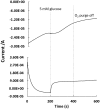Fabrication of highly effective hybrid biofuel cell based on integral colloidal platinum and bilirubin oxidase on gold support
- PMID: 30397324
- PMCID: PMC6218521
- DOI: 10.1038/s41598-018-34740-w
Fabrication of highly effective hybrid biofuel cell based on integral colloidal platinum and bilirubin oxidase on gold support
Abstract
A hybrid biofuel cell (HBFC) is explored as a low-cost alternative to abiotic and enzymatic biofuel cells. Here the HBFC provides an enzymeless approach for the fabrication of the anodic electrode while employing an enzymatic approach for the fabrication of the cathodic electrode to develop energy harvesting platform to power bioelectronic devices. The anode employed 250 μm braided gold wire modified with colloidal platinum (Au-co-Pt) and bilirubin oxidase (BODx) modified gold coated Buckypaper (BP-Au-BODx) cathode. The functionalization of the gold coated multi-walled carbon nanotube (MWCNT) structures of the BP electrodes is achieved by 3-mercaptopropionic acid surface modification to possess negatively charged carboxylic groups and subsequently followed by EDC/Sulfo-NHS (1-Ethyl-3-(3-dimethylaminopropyl) carbodiimide hydrochloride and N-Hydroxysulfosuccinimide) crosslinking with BODx. The integration of the BODx and gold coated MWCNTs is evaluated for bioelectrocatalytic activity. The Au-co-Pt and BP-Au-BODx exhibited excellent electrocatalytic activity towards glucose oxidation with a linear dynamic range up to 20 mM glucose and molecular oxygen reduction, respectively. The HBFC demonstrated excellent performance with the largest open circuit voltages of 0.735 V and power density of 46.31 μW/cm2 in 3 mM glucose. In addition, the HBFC operating on 3 mM glucose exhibited excellent uninterrupted operational stability while continuously powering a small electronic device. These results provide great opportunities for implementing this simple but efficient HBFC to harvest the biochemical energy of target fuel(s) in diverse medical and environmental applications.
Conflict of interest statement
The authors declare no competing interests.
Figures









Similar articles
-
Carbon Nanotube-Cellulose Pellicle for Glucose Biofuel Cell.Annu Int Conf IEEE Eng Med Biol Soc. 2018 Jul;2018:1-4. doi: 10.1109/EMBC.2018.8513229. Annu Int Conf IEEE Eng Med Biol Soc. 2018. PMID: 30440309
-
5,5-Dithiobis(2-nitrobenzoic acid) pyrene derivative-carbon nanotube electrodes for NADH electrooxidation and oriented immobilization of multicopper oxidases for the development of glucose/O2 biofuel cells.Biosens Bioelectron. 2017 Jan 15;87:957-963. doi: 10.1016/j.bios.2016.09.054. Epub 2016 Sep 16. Biosens Bioelectron. 2017. PMID: 27665518
-
Fabrication of high performance bioanode based on fruitful association of dendrimer and carbon nanotube used for design O2/glucose membrane-less biofuel cell with improved bilirubine oxidase biocathode.Biosens Bioelectron. 2013 Dec 15;50:186-93. doi: 10.1016/j.bios.2013.05.047. Epub 2013 Jun 24. Biosens Bioelectron. 2013. PMID: 23850787
-
From fundamentals to applications of bioelectrocatalysis: bioelectrocatalytic reactions of FAD-dependent glucose dehydrogenase and bilirubin oxidase.Biosci Biotechnol Biochem. 2019 Jan;83(1):39-48. doi: 10.1080/09168451.2018.1527209. Epub 2018 Oct 1. Biosci Biotechnol Biochem. 2019. PMID: 30274547 Review.
-
Progress on implantable biofuel cell: Nano-carbon functionalization for enzyme immobilization enhancement.Biosens Bioelectron. 2016 May 15;79:850-60. doi: 10.1016/j.bios.2016.01.016. Epub 2016 Jan 7. Biosens Bioelectron. 2016. PMID: 26785309 Review.
Cited by
-
Flexible battery-less wireless glucose monitoring system.Sci Rep. 2022 Jul 19;12(1):12356. doi: 10.1038/s41598-022-16714-1. Sci Rep. 2022. PMID: 35854130 Free PMC article.
-
Optimizing Covalent Immobilization of Glucose Oxidase and Laccase on PV15 Fluoropolymer-Based Bioelectrodes.J Funct Biomater. 2022 Dec 1;13(4):270. doi: 10.3390/jfb13040270. J Funct Biomater. 2022. PMID: 36547530 Free PMC article.
References
-
- Centers for Disease Control and Prevention. National Diabetes Statistics Report, 2017. Atlanta, GA: Centers for Disease Control and Prevention, US Department of Health and Human Services, https://www.cdc.gov/diabetes/data/statistics/statistics-report.html (2017)
-
- Park, C., Chou, P. H., Bai, Y., Matthews, R. & Hibbs, A. An ultra-wearable, wireless, low power ECG monitoring system, 2006 IEEE Biomedical Circuits and Systems Conference, London, 2006, 241–244 (2006).
-
- Thiele L, Moser C, Benini L, Brunelli D. Adaptive Power Management for Environmentally Powered Systems. In IEEE Transactions on Computers. 2010;59:478–491. doi: 10.1109/TC.2009.158. - DOI
-
- Narayan SR, Valdez TI. High-energy portable fuel cell power sources. Electrochem. Soc. Interface. 2008;17:40–45.
Publication types
MeSH terms
Substances
LinkOut - more resources
Full Text Sources

